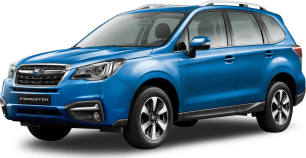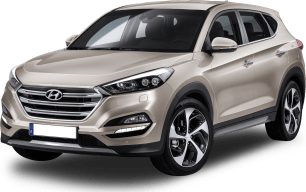The Tucson is a good car to live with. Like most Hyundais it is unusually easy to set the right position behind the wheel, with an excellent relationship between the pedals, wheel and the hip-point of the driver's seat. There's tons of adjustment to ensure you hit the spot.
Vision is good in almost all directions, apart from over the shoulder on the driver's side where the closing glass line tightens up. It's not an especially high car but feels high enough that you're above the traffic.
Although this isn't specifically an offroad review, ground clearance is 182mm with nothing on-board and you could almost u-turn in a normal suburban street with a turning radius of 10.6 metres.
A startlingly good feature across the entire range is the ride and handling.
Like Mazda, Hyundai has punted on buyers liking a multi-link rear rear suspension. It means a better balanced chassis (when done right) but more importantly, impressive ride compared to a couple of the segment's other cars which have cheaper, more compact torsion beam rear ends.
Multi-link-equipped cars cost more, but it's worth it. Australian Tucsons have individual spring and damper settings from Hyundai's very own local suspension tuning team.
Each Tucson has its own distinct driving character according to engine and transmission combination.
The only bugbear with the FWD cars is an over-enthusiastic propensity to centre the steering wheel if you give it a little too much throttle exiting a corner.
Each Tucson has its own distinct driving character according to engine and transmission combination.
The Active and Active X are roughly the same from behind the wheel, with just nuanced differences to do with the different wheel sizes. In both cases the six-speed automatic is a good choice, with a finely-judged shift quality and the ability to work out what you're up to. As it's only FWD, it's not an off-roader, although the curious inclusion of hill descent control suggests it might be. Then again, on the supplied tyres, perhaps not.
The GDI motor is quiet unless provoked to the redline and returns fair fuel economy around town, lacking as they are in stop-start or energy recovery. In fact, no Tucson features stop-start, the only real glaring spec omission. Performance figures aren't particularly quick, the GDI managing a 0-100km/h time of 10.2 seconds.
Moving up the range, and with the addition of a 1.6-litre turbo petrol and seven-speed dual clutch transmission, are the Elite and Highlander AWD models. The 1.6 turbo is very much at home in the Tucson, with a small bump in power from the Active X's 121kW to 130kW but a 20 per cent jump in torque to 265Nm. While the front drivers are the best handlers, the turbo 1.6-powered cars have the best engine.
It's a smooth, happy unit, hauling the Tucson around with vigour. The dual-clutch transmission isn't perfect, with hesitation at low speeds and a frustrating inability to quickly shift from D to R to D when you're in a hurried three-point-turn manoeuvre.
Apart from that little drama, this combination does turn the Tucson into a more relaxed car in traffic as that nice stream of accessible torque means fewer revs needed to make things happen and it's less sensitive to heavy loads.
The turbo petrol cars also very effectively mask the weight increase of around 145kg over the FWD models, with stronger acceleration from step off and in the gears. Four fatter tyres handle getting the power to the road and all the good bits of the Active X's ride and handling are transferred to AWD petrols, meaning a good change of direction and best-in-class ride.
The final combination is the AWD 2.0-litre turbo diesel found in the Elite and Highlander diesels. Reverting back to the six-speed automatic found in the naturally aspirated front drivers, the diesel is a very strong performer and, like the petrol 1.6, is a relaxed car in daily driving.
Only the CX-5 matches the Tucson for handling but it can't touch it for overall ride quality or road noise levels.
It is almost 200kg heavier than the Active and Active X, but the 400Nm of torque - almost double - means you can load up and still get around swiftly. Performance figures from 0-100km/h are similar to the 1.6 petrol (just over nine seconds for the diesel, and a tick under for the petrol) but in the gears acceleration is mighty. The diesel is the one for towing.
As in the petrol, the CRDis have plenty of grip on loose or wet surfaces and handle well in the dry, with good steering and a keen change of direction for a mid-size SUV, especially consi dering the further weight gain of the diesel engine. The diesel only comes with 4 wheel drive and any of the all-wheel drivers will tackle moderate off-road challenges.
Only the CX-5 matches the Tucson for handling but it can't touch it for overall ride quality or road noise levels, despite a similar rear suspension set-up. The Tucson is also exceptionally quiet for a car in this class, especially for front seat passengers.
Rear seat passengers enjoy a good ride, although the middle seat is quite firm for backsides of any size.











.png)















































.png)























 copy.png)















